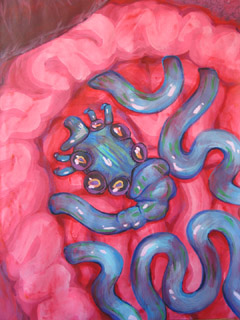
The Vivecta is a hideous intestinal parasite. It is found in The Congos, and is associated with swampy areas.
Parasitic worms typically enter the host organism orally, and then attach to the interior walls of the gastro-intestinal tract. The Vivecta is unusual in this respect; it enters its host by burrowing through the skin, and then attaches itself to the outer wall of the intestines.
At this point in its life, the Vivecta looks like a twelve-eyed, blue-green iridescent beetle. Cutting pincers at either end of the body make incisions into the intestine. Partially digested food passes from the first incision, through the Vivecta's body, and back out through the second incision into the host again.
As the parasite ages, the carapace splits in two, and a long, ropey body develops between the two "heads". Each head progressively clamps down on the intestine with four strong legs -- until the Vivecta's body completely bypasses normal digestive flow. In essence, the parasite simply becomes an extra length of intestine.
In the late stages of its development, the Vivecta can measure 20+ feet in length. In cattle and in humans, presence of the parasite is sometimes mistaken for pregnancy. Hosts are typically somewhat malnourished -- but otherwise in good health.
Reproduction is parthenogenetic. Dozens of worm-like larva develop off the hoods of the two heads. They grow quickly while in the host's body, until after a week they are approximately nine inches long. Whereas the original Vivecta passively conforms itself to the shape of the host's existing digestive tract, the infants writhe spasmodically -- which is disturbingly visible through the skin of the the host's abdomen.
The larval Vivecta leave the host en masse, first burrowing through the intestine's wall, then passing out all at once through the nether orifice. The many perforations that they make in the intestines cause severe septicaemia, which almost always results in death for the host.
There are three distinct phases in the Vivecta's life cycle. After leaving the host's body, the larvae look like black, twelve-eyed snakes. Legless, they slither outward into the environment seeking soft, wet earth in which to burrow. When they find a suitable spot, the "snakes" dig into the ground and cocoon themselves in masses of sticky fiber.
Two weeks later, the Vivecta emerge -- in the form of a small winged fly. The flies seek out warm-blooded hosts... And the life cycle begins again.


2 comments:
yech! is there no defense?
Bravo to you for the hard work and good results overall!
I'd recommend Wayne Barlowe's work and suggest working in Photoshop as i find it so much easier to use and so so much easier to learn and experiment with.
Best wishes!
:)lee moyer
Post a Comment